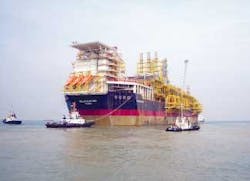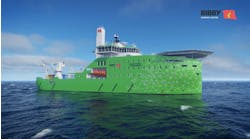FPSO heads for Campos basin
Halliburton subsidiary KBR and Petrobras have achieved a milestone in the development of the Barracuda and Caratinga fields in the Campos basin offshore Brazil. The first of the two oil tankers converted into FPSOs began its journey Oct. 13.
The Barracuda FPSO,P-43, left the quay at the Maua-Jurong shipyard in Niteroi, Rio de Janeiro State, for sea trials and final inspections before sailing to the deepwater oil and gas field 160 km east of Macae, northeast of Rio de Janeiro. Upon arrival at its installation site in the Campos basin, the P-43 was moored, and hook-up and offshore commissioning carried out. Petrobras expected first oil in early November.
Belanak Natuna is the largest FPSO project the P.T. McDermott Indonesia yard has handled to date. The FPSO is one of the most complex processing systems installed offshore and is the first offshore liquefied petroleum gas (LPG) facility on a floating vessel in the Asia Pacific region.
null
The Barracuda-Caratinga project includes the sister field development Caratinga. The Caratinga FPSO,P-48, is being converted in the BrasFELS shipyard in Angra dos Reis, Brazil, and is one of the first FPSOs to be built solely in Brazil. It was scheduled to sail to its installation site in the Campos basin this month and to begin oil production in January 2005.
Together, the deepwater Barracuda and Caratinga fields cover 493 sq km in the Campos basin. The fields will produce close to 300,000 b/d, approximately 20% of the current output from this offshore region. Each vessel will store 2 MMbbl of oil.
We are proud to be part of this landmark project in South America, which represents one of the largest offshore engineering, procurement, installation, and construction projects ever undertaken by a single contractor,” Andy Lane, president and CEO of KBR, Halliburton’s engineering and construction group, says.
Belanak Natuna begins production in Southeast Asia
The Belanak Natuna FPSO sailed from Batam, Indonesia, in mid October to its installation site in the Belanak field in the South Natuna Sea block B, 200 km northeast of Singapore.
“We are proud to be part of this landmark project in Indonesia, which is the first FPSO of this magnitude and complexity to be executed in Asia Pacific,” Andy Lane, president and CEO of Halliburton’s engineering and construction group, says.
TheBelanak Natuna FPSO is one of the most complex processing systems to be installed offshore. It is the first offshore liquefied petroleum gas (LPG) facility on a floating vessel in the Asia Pacific region. The newbuild FPSO will be the central processing facility serving as a regional hub for the eastern portion of block B, including the Belanak fields and potential future developments.
PT Brown & Root Indonesia in conjunction with DKES Inc., won the contract to design, engineer, procure, construct, and install the FPSO, moorings, and flexible risers. The companies executed all project management services and engineering from Indonesia and Singapore.
P.T. Brown & Root Indonesia awarded J. Ray’s Indonesian operations, P.T. McDermott Indonesia, the contract in July 2001 to fabricate topside modules and integrate the facilities on the FPSO hull.
Integration of the 25,000 tonnes process topsides onto the hull began in September 2003 and was completed in June 2004. The topsides comprise eight modules, a flare boom, and pipe racks.
“Belanak Natuna is the largest FPSO project that the yard has handled to date,” Steve Roll, president director of PTMI, says.
PTMI invested over $5.25 million in upgrading its existing quayside to handle the full range of FPSO vessels and increase the yard’s scope of work from purely topside module fabrication to also include topside to hull integration projects.
China’s Dalian New Shipbuilding Heavy Industry Co. Ltd. constructed the FPSO hull, which has a storage capacity of 1 MMbbl. One of the largest hulls constructed for an FPSO, it measures 285 m in length and 58 m in width. The hull was designed and built to last 30 years without the need for dry-docking, and all mechanical equipment is expected to last for this period with routine maintenance offshore.
Multiwave brings C-Orion into operation
Norway’s Multiwave Geophysical brought a new vessel into operation in early October as the company geared up for a major seismic acquisition campaign in the Mediterranean, which began later in the month. The vessel,C-Orion, was rigged by Multiwave specifically for the project, which will include a large-scale 2D survey as well as a 3D program.
Specifically designed for acquiring deepwater seismic surveys, theC-Orion is a six-streamer vessel and provides a high-capacity 3D solution for delivering high-quality data, Multiwave says.
The vessel, owned by Edison Chouest, is equipped with some of the latest geophysical acquisition technology.
We always look extremely carefully at the alternatives when selecting a vessel,” Rick Donoghue, Multiwave’s vice president sales and marketing, says, “and chose theC-Orion as it is provides a very flexible platform for our ‘on demand’ business model.”
New AHTSs for Seabulk
Seabulk International Inc. signed contracts with Labroy Shipbuilding and Engineering Pte Ltd. of Singapore for four newbuild anchor handling tug supply vessels (AHTSs) for its international offshore fleet. Delivery of the vessels is scheduled for 2006. The contracts include an option for four additional vessels.
The newbuild AHTSs are in the 7,000-hp range and are in high demand in areas of expanding offshore activity, such as West Africa and Southeast Asia.
Gerhard E. Kurz, chairman and chief executive at Seabulk says, “These are multi-functional, high-specification vessels that can work anywhere in the world.”
Seabulk has ordered 15 new vessels over the last two years. The company took delivery of the seventh vessel,Seabulk Brasil in late October. One more is scheduled for delivery in 2004, and three in 2005. Most of the new vessels will serve the West African market.




